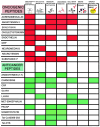Glioma and Peptidergic Systems: Oncogenic and Anticancer Peptides
- PMID: 39063232
- PMCID: PMC11277022
- DOI: 10.3390/ijms25147990
Glioma and Peptidergic Systems: Oncogenic and Anticancer Peptides
Abstract
Glioma cells overexpress different peptide receptors that are useful for research, diagnosis, management, and treatment of the disease. Oncogenic peptides favor the proliferation, migration, and invasion of glioma cells, as well as angiogenesis, whereas anticancer peptides exert antiproliferative, antimigration, and anti-angiogenic effects against gliomas. Other peptides exert a dual effect on gliomas, that is, both proliferative and antiproliferative actions. Peptidergic systems are therapeutic targets, as peptide receptor antagonists/peptides or peptide receptor agonists can be administered to treat gliomas. Other anticancer strategies exerting beneficial effects against gliomas are discussed herein, and future research lines to be developed for gliomas are also suggested. Despite the large amount of data supporting the involvement of peptides in glioma progression, no anticancer drugs targeting peptidergic systems are currently available in clinical practice to treat gliomas.
Keywords: anticancer peptides; glioblastoma; glioma; oncogenic peptides; peptide receptor; peptide receptor antagonist; peptidergic systems; peptides.
Conflict of interest statement
The authors declare no conflicts of interest.
Figures




Similar articles
-
Peptidergic Systems and Neuroblastoma.Int J Mol Sci. 2025 Apr 8;26(8):3464. doi: 10.3390/ijms26083464. Int J Mol Sci. 2025. PMID: 40331938 Free PMC article. Review.
-
Sunitinib impedes brain tumor progression and reduces tumor-induced neurodegeneration in the microenvironment.Cancer Sci. 2015 Feb;106(2):160-70. doi: 10.1111/cas.12580. Epub 2015 Feb 15. Cancer Sci. 2015. PMID: 25458015 Free PMC article.
-
Identification of two novel Chlorotoxin derivatives CA4 and CTX-23 with chemotherapeutic and anti-angiogenic potential.Sci Rep. 2016 Feb 2;6:19799. doi: 10.1038/srep19799. Sci Rep. 2016. PMID: 26831010 Free PMC article.
-
Chemoattractant receptors as pharmacological targets for elimination of glioma stem-like cells.Int Immunopharmacol. 2011 Dec;11(12):1961-6. doi: 10.1016/j.intimp.2011.08.021. Epub 2011 Sep 17. Int Immunopharmacol. 2011. PMID: 21930249 Free PMC article. Review.
-
Inhibition of PlexA1-mediated brain tumor growth and tumor-associated angiogenesis using a transmembrane domain targeting peptide.Oncotarget. 2016 Sep 6;7(36):57851-57865. doi: 10.18632/oncotarget.11072. Oncotarget. 2016. PMID: 27506939 Free PMC article.
Cited by
-
Editorial for the Special Issue "Current Research on Cancer Biology and Therapeutics: 2nd Edition".Int J Mol Sci. 2024 Nov 2;25(21):11777. doi: 10.3390/ijms252111777. Int J Mol Sci. 2024. PMID: 39519328 Free PMC article.
-
Peptidergic Systems and Neuroblastoma.Int J Mol Sci. 2025 Apr 8;26(8):3464. doi: 10.3390/ijms26083464. Int J Mol Sci. 2025. PMID: 40331938 Free PMC article. Review.
References
-
- Muñoz M., Coveñas R. Neurokinin-1 Receptor: A New Promising Target in the Treatment of Cancer. Discov. Med. 2010;10:305–313. - PubMed
-
- Louis D.N., Perry A., Wesseling P., Brat D.J., Cree I.A., Figarella-Branger D., Hawkins C., Ng H.K., Pfister S.M., Reifenberger G., et al. The 2021 WHO Classification of Tumors of the Central Nervous System: A Summary. Neuro-Oncology. 2021;23:1231–1251. doi: 10.1093/neuonc/noab106. - DOI - PMC - PubMed
Publication types
MeSH terms
Substances
LinkOut - more resources
Full Text Sources

